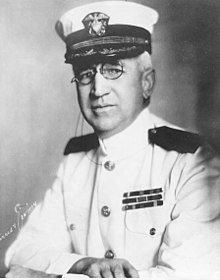Edwin Taylor Pollock
| Edwin Taylor Pollock | |
|---|---|

Capt. Pollock as Superintendent of the U.S. Naval Observatory
|
|
| Born |
October 25, 1870 Mount Gilead, Ohio |
| Died | June 4, 1943 (aged 72) Washington, D.C. |
| Allegiance | United States of America |
| Service/branch | United States Navy |
| Years of service | 1893–1927 |
| Rank | Captain |
| Commands held |
USS Virginia USS Kearsarge USS Salem USS Alabama USS Hancock USS George Washington USS Oklahoma Commandant U.S. Naval Station Tutuila Superintendent U.S. Naval Observatory |
| Battles/wars | Battle of Santiago de Cuba |
| Awards | Navy Cross |
| Other work | Military Governor of the U. S. Virgin Islands (acting) and American Samoa |
Edwin Taylor Pollock (October 25, 1870 – June 4, 1943) was a career officer in the United States Navy, serving in the Spanish–American War and in World War I. He was later promoted to the rank of captain. Like many naval officers, his name was often abbreviated using initials: E. T. Pollock.
As a young ensign, Pollock served aboard USS New York during the Spanish–American War. After the war, he rose through the ranks, served on several ships, and did important research into wireless communication. In 1917, less than a week before the United States entered World War I, he won a race against a fellow officer to receive the U.S. Virgin Islands from Denmark, and served as the territory's first acting governor. During the war, he was promoted to captain and a vessel under his command transported 60,000 American soldiers to France, for which he was awarded a Navy Cross. Afterward, he was made the eighth Naval Governor of American Samoa and then the superintendent of the United States Naval Observatory, before retiring in 1927.
Originally from Mount Gilead, Ohio, Pollock attended the United States Naval Academy and, as a midshipman, was assigned to USS Lancaster and USS Monocacy. He graduated with a rank of ensign in 1893.
After graduation, Pollock returned to Ohio and married Beatrice E. Law Hale on December 5. Two weeks later, he was assigned to the cruiser USS New York during its initial shake-down. He was subsequently assigned to the gunboat USS Machias for an expedition to China. He remained in China for two and a half years as part of the Asiatic Squadron, then transferring to USS Detroit before returning home in 1897. On his return home, the Spanish–American War was heating up and he was reassigned to the New York, to see service in Cuba and Puerto Rico, eventually taking part in the Battle of Santiago de Cuba.
...
Wikipedia
